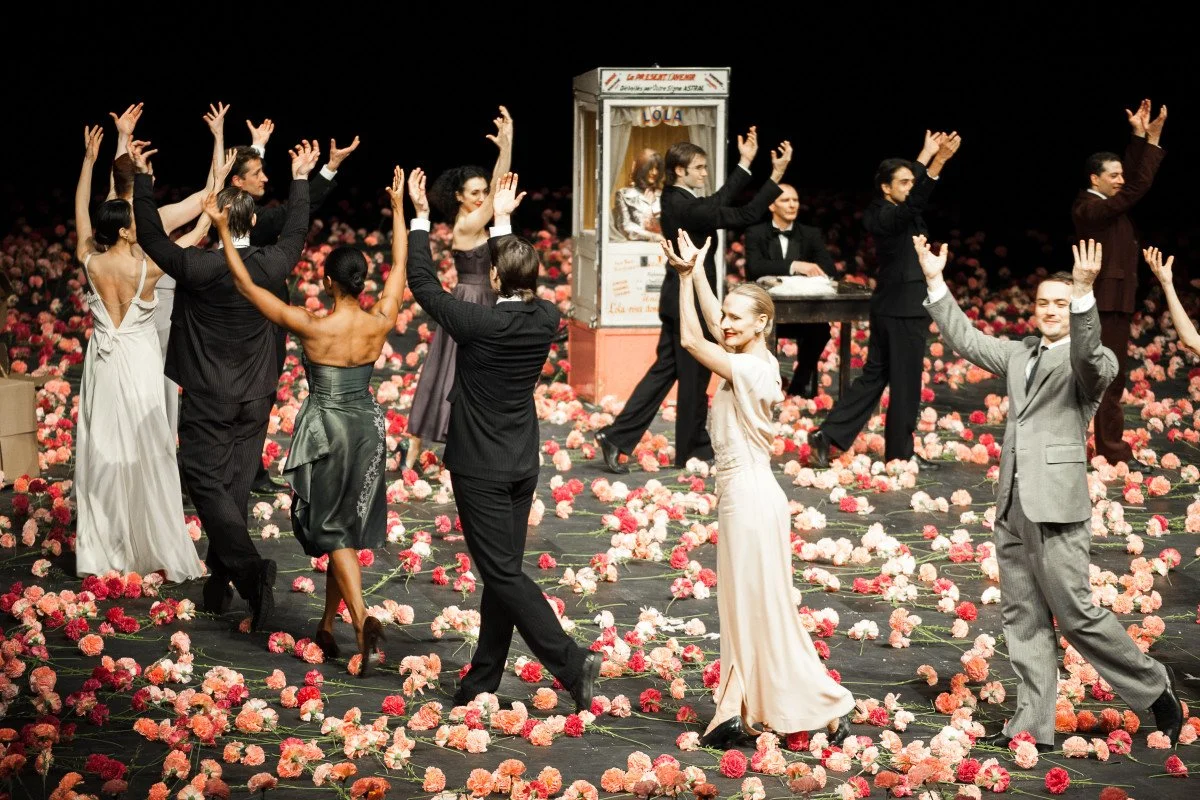Pina: Queen of Chaotic Good
“There is only the feeling of something, which I madly want to know more about”
– Pina Bausch
There are certain rites of passage that come with carving a career in, or immersing yourself in the world of, a particular artform. Inspirational first encounters with the work of an icon being chief among them.
The first time ever I saw that painting, heard that song, read that book…
But sometimes we inexplicably bypass the big ones. “How have you never seen her work?” a friend whispers. “She’s an icon, a game-changer! You won’t be the same person afterwards!” Et cetera, et cetera…
Fine. Ever the late bloomer, I saw the work of German choreographic impressaria Pina Bausch live, for the first time, at the grand old age of 37. Aka, last week. I have no explanation as to why, given that my degree is in dance and I have worked in the industry for nearly twenty years. Privilege of access is no small thing. I probably should have seen her work by now, and have no doubt taken previous opportunities for granted. But we are where we are.
And where we are is Sadler’s Wells Theatre, watching a revival of Nelken (Carnations) – a prized production from the repertoire of Tanztheater Wuppertal Pina Bausch + Terrain Boris Charmatz.
Buckle up
A creeping sense of foreboding grips me from the off. The stage – carpeted with 8000 silk carnations, a dense landscape of delicate stems and blowsy pink petals – is already set and visible as we take our seats. Beautiful, but doomed!, I mutter to myself, before remembering not to live commentate for the sake of my neighbours in the slips. How can something so simple, so beautiful, so goddamn aesthetically pleasing not be cause for concern?
Everything I’ve ever heard about Bausch’s work suggests it will speak to my default cheerful-cum-melancholy nature, and I’m girding my loins for the bitter in the sweet.
Nelken, originally staged in 1982, is without narrative – the red thread being the recurrence of key themes and motifs. An episodic odyssey through a series of vignettes, it explores some of the cornerstones of humanity: cruelty, tragedy, tenderness, ridiculousness, humour and beauty.
Things start slowly, and in silence, as the first performer stalks the stage, making their way straight into the audience (I suspect, putting those who hate even the whiff of audience participation, myself included, on high alert – this is contemporary dance, after all). But the feeling in the room, a full house, is warm and open. Someone in the stalls is approached, gently invited to take the dancer’s arm, and led out of the auditorium. Other dancers appear and in turns follow suit, until a handful of people have been courted out of the theatre and back in again. Strains of George Gershwin kick in (more on that later).
We don’t know what’s happened, or why, or what will happen next, but our collective curiosity is already piqued. Life is uncertainty. People are putty. And this sets the tone for the rest of the evening.
“Dance, dance, otherwise we are lost”
For some of us, words are how we make sense of things; how we find ourselves and others amidst the mess. For Pina Bausch, her most famous quote: “dance, dance, otherwise we are lost”, speaks for itself.
The sentiment is not without irony here, because in Nelken I often find myself baffled and, well, a bit lost, albeit captivated from the off. As one bizarre vignette bleeds into the next, we witness the sublime and the ridiculous – and often both at once.
Humiliation and humour dance a tense two-step. Power play comes up a lot. Cheeks are slapped (face and arse), and faces are masochistically buried in chopped onions (which I can smell from my seat). The most disturbing moment for me arrives later in the show, when a troubling parent-child dynamic is brought to life, with one dancer force-feeding the other a succession of seemingly innocuous fairy cakes. It’s insidious. And delivered with the kind of subtle, deliberate and repetitive movement language that screams abuse of power. Ick.
As the action unfolds, these oddly captivating scenes gradually illuminate the abject mess of what it is to live: in relation to each other, and in relation to ourselves. In the face of absurdity, bafflement eventually gives way to a kind of clarity: humans are brilliant and awful all at once, and most of us are just fumbling around, hopefully, doing the best we can. Oh, and it helps to have a sense of humour too.
There’s melancholy in spades. And also actual spades, when two of the dancers methodically spoon soil from kiddies’ plastic buckets onto their heads (your guess is as good as mine). Gesture dominates the movement language throughout, and the choreography is far from overtly dancey, so when the dancers do get to show off their dancer chops, it’s more impactful.
My favourite part is when four Alsatians are brought on stage to bear witness to the humans as they maraud through the flowers on all fours. An absurdist nod to the animal part of human nature, playfulness and humiliation, all rolled into one. The dogs are terribly good, expressing their views on the scene with a few low-key woofs and whimpers.
Suddenly, everything feels very poignant. And I’m surprised to find that I’ve got a lump in my throat, and an urge (which I resist) to invade the stage and join in. But maybe it’s just that I really miss dancing, and really want a dog. Or maybe I want to be a dog. It’s confusing. And I start to think about love.
Sound and vision
Notably, the only reference to romantic love (that I pick up), arrives early on in the piece: a man in a suit signs a repetitive mime to the lyrics of Gershwin’s A Man I Love as the track wafts in the background. It’s captivating and I want more of it.
For a work that offers such a comprehensive and deft physical rendering of what it feels like to be alive, unearthing and flooding with light so many essential parts of human nature, the omission of sexual and romantic relational dynamics feels like a missed opportunity. It’s my only gripe with the piece. Or perhaps I’m missing something? Or perhaps I’m not and perhaps it’s refreshing?
Nevertheless, there’s something sensual and erotic about Bausch’s work. Erotic in the broadest sense – libido as in lust for life.
That sensuality shows up in the sound, set and costume as well as the movement, and it’s rendered beautifully. Bausch was known for her collaborations (she worked with set designer Peter Pabst for 30 years up until her death in 2009), achieving a close, co-dependent melding of all the creative elements in her work.
Setting the stage with elemental foundations like soil or flowers – a common set design choice – quite literally grounds us in the space. Earth, water, flora and even fauna (woof), and the inventive use of pedestrian props – chairs, tables, cardboard boxes, cake, onions – all remind us of the practical and the tangible as we boulder our way from one existential crisis to the next.
Marion Cito’s delectable costumes of suits, silk slips, evening dresses and heels – worn interchangeably regardless of gender – are a signature aesthetic, and lend a nostalgic, dream-like quality to the proceedings.
When woven together with text, jazz and classical music (to Gershwin, add the likes of Schubert, Quincy Jones and Billie Holiday), it feels as though we’re inhabiting a recognisable yet abstract past. But we’re in the present – a parallel world made up of fragments of the familiar, tilted on a strange new axis. And it feels unexpectedly prescient.
There are references to nature and life-cycles throughout. Towards the end of the show, with the carnations now wilted and scattered underfoot, the dancers execute one of the signature choreographic devices in Bausch’s work: the line. One behind the other, they methodically snake their way through the battered blooms, repeating a pedestrian mime that represents the four seasons. They eyeball the audience with warm and inviting smiles. Now putty in their hands, we are encouraged to join the last phrase of the mime. Hundreds of arms obligingly stretch to the ceiling, sweeping up, down and round, as if hugging the air before us.
Eventually, the dancers snake off stage and break the fourth wall again, this time picking out audience members to embrace for real. I’m delighted to be one of the chosen ones, as the powdery, floral-scented warmth of a mamacita in a rosy-hued evening gown envelopes me. It’s a tender moment. And I’m so glad I came.
Chaotic good
Nelken is a classy spectacle, full of wry humour and profound humanity. For a dance theatre show knocking on the door of 2 hours without an interval, it is long. I have the attention-span of the proverbial gnat, but my attention only drifts once, about two thirds of the way through (aptly, I can’t remember during which bit), and I am mostly captivated by the sheer bedlam of it all.
I don’t mind that I don’t really know what’s going on, because I feel it. To get the sense of things, to surrender to surprise at every turn, is enough.
The cast of 20 performers is superb throughout. They slip in and out of different facets of their ‘characters’ (although ‘embodied archetypal characteristics’ feels more accurate). They traverse the gamut of human emotion and behaviour with panache and a light touch. As an ensemble, they collectively command the stage with a sense of egalitarian freedom whilst making room for each other’s uniqueness. It’s a joy to watch.
For a work that was made over four decades ago, Nelken feels both current and timeless. A testament to the quality of the craft in the first place, and to the current cohort tasked with stewarding the work, who have given it life again.
I don’t know if it changed me. But I was enlivened and entertained, left baffled and bewildered, and blown open to the point of tears. Which is exactly the sort of experience that gives me hope – and exactly what I was hoping for.
Often referred to simply as ‘Pina’, the work’s creator is more than worthy of the first-name-only moniker, like other great artists known for pushing the form. Her reputation precedes her and then some. And rightly so, if Nelken is anything to go by. It is the epitome of ‘chaotic good’, and so, it seems, was she.
So, brava! Brava! And thank you, Pina. I’m sorry it took me so long. But better late than never, I hope.
Some things are worth the wait.
Photo credits: Oliver Look.








